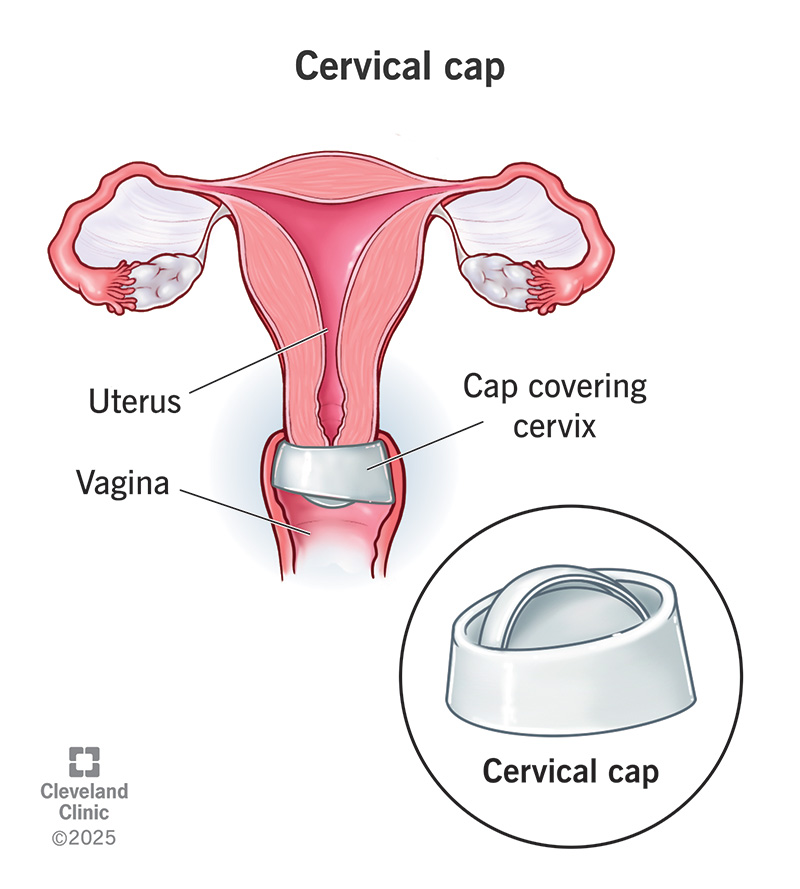Cervical caps create a physical barrier to prevent sperm from entering your cervix and uterus. It’s a form of birth control. Cervical caps are most effective when used with spermicide. They’re available by prescription and come in three different sizes.
Advertisement
Cleveland Clinic is a non-profit academic medical center. Advertising on our site helps support our mission. We do not endorse non-Cleveland Clinic products or services. Policy

A cervical cap is a small cup you put in your vagina before sex to prevent pregnancy. It’s made of silicone or rubber. The cap covers your cervix so sperm can’t reach an egg. Suction helps it stay in place.
Advertisement
Cleveland Clinic is a non-profit academic medical center. Advertising on our site helps support our mission. We do not endorse non-Cleveland Clinic products or services. Policy
Some people describe a cervical cap as a sailor’s hat. It has a wide, upturned brim with a dome or bowl in the center. It has a strap across the dome to help you remove it after use. The only cervical cap approved in the U.S. is called FemCap®.
Cervical caps come in different sizes (small, medium and large). Your healthcare provider helps “fit” your cervical cap and writes you a prescription. Certain changes in your body, like having a baby, can affect the size you need. If that happens, you’ll need to be refitted. Using the right size is key. A poor fit can make the cap less effective and increase your risk of pregnancy.
A cervical cap is less effective if you’ve had a vaginal delivery. This is because your vagina and cervix stretch during childbirth. The cervical cap is about 80% to 90% effective if you haven’t given birth. It’s about 60% to 74% effective if you have.
Cervical caps only work when they’re used correctly. If you don’t follow the instructions or use it consistently, your chance of pregnancy goes up. The cap must fit snugly over your cervix.
You can add spermicide to the cervical cap to kill any sperm that might get around the cap. This also increases the cap’s effectiveness.
Advertisement
Cervical caps aren’t as effective as other birth control options, like patches, rings, or intrauterine devices (IUDs).
To insert a cervical cap:
You may need to practice inserting your cervical cap until you get it right. Before each use, check the cap for holes or other damage that may allow sperm to sneak through the barrier. If your cervical cap is damaged, don’t use it.
Keep your cervical cap in place for at least six hours after the last time you have sex. Don’t leave it in longer than 48 hours total. If you have sex again, make sure to add more spermicide each time.
To remove a cervical cap:
Finally, wash your cervical cap with warm water and mild soap. Let it dry completely. Then, place it in the container it came in.
With proper care, a cervical cap can last for up to two years. Be sure to clean it after each use and store it safely. Check regularly for any signs of damage or wear. Some tips for caring for your cervical cap include:
Cervical caps are available through prescription only. Most health insurance plans cover birth control devices. But you’ll need to get a prescription from your healthcare provider.
Some of the benefits of using a cervical cap include:
Advertisement
Cervical caps require consistent and proper use every time you have sex. Cervical caps can come out of place during sex, especially if they aren’t the right size. Other disadvantages include:
Your provider needs to refit your cervical cap after:
Using a cervical cap may increase your risk of developing:
It’s important to remove your cervical cap after 48 hours to reduce your risk of developing TSS. You can also develop TSS if you wear a cervical cap during your period. If you can’t remove your cervical cap, visit your provider so they can remove it for you.
If you have a history of these conditions, a cervical cap may not be right for you:
Advertisement
You also shouldn’t use a cervical cap if:
Contact your provider if you’re using a cervical cap for birth control and experience the following symptoms:
You should also contact your provider if you can’t remove the cervical cap or it gets stuck (this is rare).
It’s possible. Most partners won’t feel it, though, especially if it’s in the right position.
No, an IUD is a completely different birth control device.
A cervical cap is a small, reusable birth control device that blocks sperm to prevent pregnancy. It’s not super effective. But it can be more effective if you use it with a spermicide. It’s also less effective if you’ve had a vaginal childbirth. If you’re thinking about using one, talk to your healthcare provider. They’ll need to fit you for the right size and show you how to put it in and take it out. Be sure to follow the instructions that come with it. You should take the cap out within 48 hours of having sex. Leaving it in longer can increase your risk of health problems.
Advertisement
Your birth control needs to work for you. At Cleveland Clinic, we help you find the right birth control option to fit your goals and lifestyle.

Last reviewed on 07/22/2025.
Learn more about the Health Library and our editorial process.